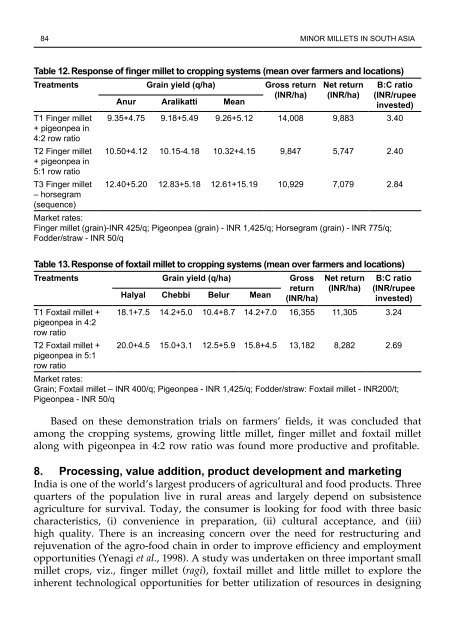Minor millets in South Asia: learnings from IFAD-NUS project in India ...
Minor millets in South Asia: learnings from IFAD-NUS project in India ...
Minor millets in South Asia: learnings from IFAD-NUS project in India ...
You also want an ePaper? Increase the reach of your titles
YUMPU automatically turns print PDFs into web optimized ePapers that Google loves.
84 m<strong>in</strong>or <strong>millets</strong> <strong>in</strong> south asia<br />
Table 12. Response of f<strong>in</strong>ger millet to cropp<strong>in</strong>g systems (mean over farmers and locations)<br />
Treatments Gra<strong>in</strong> yield (q/ha) Gross return<br />
Anur Aralikatti Mean<br />
(INR/ha)<br />
Net return<br />
(INR/ha)<br />
B:C ratio<br />
(INR/rupee<br />
<strong>in</strong>vested)<br />
t1 F<strong>in</strong>ger millet<br />
+ pigeonpea <strong>in</strong><br />
4:2 row ratio<br />
9.35+4.75 9.18+5.49 9.26+5.12 14,008 9,883 3.40<br />
t2 F<strong>in</strong>ger millet<br />
+ pigeonpea <strong>in</strong><br />
5:1 row ratio<br />
10.50+4.12 10.15-4.18 10.32+4.15 9,847 5,747 2.40<br />
t3 F<strong>in</strong>ger millet<br />
– horsegram<br />
(sequence)<br />
market rates:<br />
12.40+5.20 12.83+5.18 12.61+15.19 10,929 7,079 2.84<br />
F<strong>in</strong>ger millet (gra<strong>in</strong>)-<strong>in</strong>r 425/q; pigeonpea (gra<strong>in</strong>) - <strong>in</strong>r 1,425/q; horsegram (gra<strong>in</strong>) - <strong>in</strong>r 775/q;<br />
Fodder/straw - <strong>in</strong>r 50/q<br />
Table 13. Response of foxtail millet to cropp<strong>in</strong>g systems (mean over farmers and locations)<br />
Treatments Gra<strong>in</strong> yield (q/ha) Gross Net return B:C ratio<br />
Halyal Chebbi Belur Mean<br />
return<br />
(INR/ha)<br />
(INR/ha) (INR/rupee<br />
<strong>in</strong>vested)<br />
t1 Foxtail millet +<br />
pigeonpea <strong>in</strong> 4:2<br />
row ratio<br />
18.1+7.5 14.2+5.0 10.4+8.7 14.2+7.0 16,355 11,305 3.24<br />
t2 Foxtail millet +<br />
pigeonpea <strong>in</strong> 5:1<br />
row ratio<br />
market rates:<br />
20.0+4.5 15.0+3.1 12.5+5.9 15.8+4.5 13,182 8,282 2.69<br />
gra<strong>in</strong>; Foxtail millet – <strong>in</strong>r 400/q; pigeonpea - <strong>in</strong>r 1,425/q; Fodder/straw: Foxtail millet - <strong>in</strong>r200/t;<br />
pigeonpea - <strong>in</strong>r 50/q<br />
Based on these demonstration trials on farmers’ fields, it was concluded that<br />
among the cropp<strong>in</strong>g systems, grow<strong>in</strong>g little millet, f<strong>in</strong>ger millet and foxtail millet<br />
along with pigeonpea <strong>in</strong> 4:2 row ratio was found more productive and profitable.<br />
8. Process<strong>in</strong>g, value addition, product development and market<strong>in</strong>g<br />
<strong>India</strong> is one of the world’s largest producers of agricultural and food products. Three<br />
quarters of the population live <strong>in</strong> rural areas and largely depend on subsistence<br />
agriculture for survival. Today, the consumer is look<strong>in</strong>g for food with three basic<br />
characteristics, (i) convenience <strong>in</strong> preparation, (ii) cultural acceptance, and (iii)<br />
high quality. There is an <strong>in</strong>creas<strong>in</strong>g concern over the need for restructur<strong>in</strong>g and<br />
rejuvenation of the agro-food cha<strong>in</strong> <strong>in</strong> order to improve efficiency and employment<br />
opportunities (Yenagi et al., 1998). A study was undertaken on three important small<br />
millet crops, viz., f<strong>in</strong>ger millet (ragi), foxtail millet and little millet to explore the<br />
<strong>in</strong>herent technological opportunities for better utilization of resources <strong>in</strong> design<strong>in</strong>g

















